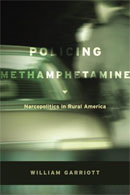Policing Methamphetamine: Narcopolitics in Rural America

Author: William Garriott
Publisher: New York: New York University Press, 2011. 201p.
Reviewer: Rashi K. Shukla | March 2012
The book Policing Methamphetamine: Narcopolitics in Rural America presents insight into the significant role that the methamphetamine problem and responses have had on local communities and the administration of justice in rural America. The signing of the U.S.A. Patriot Improvement and Reauthorization Act by former President George W. Bush in 2006, with its partial focus on methamphetamine specifically, established methamphetamine as a national concern in the United States. Increasingly, illicit drug problems are responded to with a punitive approach, and the law serves an important role in efforts to address narcotics. According to William Garriott, this has resulted in a fundamental shift in the legal culture in the U.S. No aspect of the criminal justice system has been left untouched by the focus on the need to respond to narcotics. The police, courts, and correctional systems in the U.S. are increasingly required to address the narcotics problem through directed drug enforcement activities and the adjudication and management of drug offenders. The growth in the prison system is but one result of this shift in focus and practice.
In Policing methamphetamine, the term “narcopolitics” is used to refer to "any practice of governance whose rationalization lies in the concern with narcotics" (p. 7). Ethnographic analyses of the impact of methamphetamine and narcopolitics on a small, rural community document and demonstrate "how the practices and logics of narcopolitics have become embedded in everyday expressions of political life in the United States" (p. 7). Data were gathered between 2006 and 2007 in Baker County, a small, rural community in West Virginia. Consistent with the ethnographic approach to research, information was obtained from numerous sources using diverse methods, including formal and informal interviews and observations, and reviews of archival data.
Three key features of contemporary narcopolitics are outlined in the Introduction. Chapter 1 presents a historical review of the social, legal, and political processes by which methamphetamine became "the most dangerous drug in America" (p.19). In describing the development of the methamphetamine problem, Garriott interweaves the discussion of responses and controls on the national and international level with information on patterns observed in the rural community that serves as the focus of this study. The historical overview that is presented simultaneously describes how policy responses to illicit drugs such as methamphetamine developed while challenging the viewpoint that the narcotics problem and the War on Drugs response are objectively justified. This historical discussion is thought-provoking and insightful. The decades of punitive-oriented policy responses have resulted in the solidification of the drug problem as one that is viewed as real, and not the artifact of social policies and political responses.
In chapter 2, the author takes the reader into Baker County, documenting the vast awareness among various community members of the methamphetamine problem in general and the manufacturing problem more specifically. Legal responses aimed at controlling methamphetamine production at the local level expanded the role of and expectations that citizens in the community would both formally and informally participate in police work. This "expansion of police power locally in both space and time" (p. 47) impacted many in the community, including pharmacists, state road workers, citizen volunteers, as well as those employed in the field of law enforcement itself. Local conflicts between raising knowledge and awareness of the signs of methamphetamine production and “financial disincentives to seek out signs of meth production” (p. 50) are described. In chapter 3, a review of the circumstances surrounding the activities of local methamphetamine offenders in the community is integrated into a broader discussion of the theories that underlie explanations of criminal behavior and addiction.
Theoretical, policy-oriented, and law enforcement views and responses that increasingly linked drug use, addiction, and crime impacted the manner in which offenders were treated and community members were educated in Baker County. Criminal justice system officials including police and probation officers were progressively required to become more proficient in responding to addiction and related behaviors. Here case examples are provided to document how methamphetamine offenders were processed in this environment of narcopolitics. The examples presented highlight the challenges of responding to methamphetamine offenders in a social and political environment focused on arrest and punishment. The chapter ends with an interesting discussion of the relevance of physical markers of methamphetamine addiction and the influence of these physical signs and symptoms on attributions of criminality.
Chapter 4 begins with a discussion of a young high school student who became addicted to methamphetamine, and the impact this case had on local perceptions of the problem. The shifting perceptions that “a lot of people you’d never suspect were on it” (p. 87) and “it doesn’t take a long time for good kids to go bad” (p. 87) led to an expansion of drug detection and drug surveillance practices in new places — including high schools, employment sites, hospitals, and doctors’ offices. The increased availability and use of drug detection technology impacted the local community and institutional policies in schools and places of employment. Drug testing of employees and students became an increasing part of discussions about and responses to the local drug problem. It is within this context that programs aimed at controlling drug use in schools were revised and re-marketed for parents who were concerned about drug use among their children.
Detailed descriptions of three specific cases that resulted from the operations of the Federal Drug Task Force are presented in chapter 5, to document how methamphetamine offenders were processed in the criminal justice system. The author uses these examples to illustrate how the state’s legitimacy is protected through the prosecution of methamphetamine offenders. There is little concern or debate about the prosecution of marginalized members of the community, including drug dealers. As a result, these types of offenders become targeted for prosecution, thus effectively “establishing the states legitimacy in the public eye” (p. 127).
Chapter 6 describes the perspectives of individuals directly responsible for dealing with the methamphetamine problem and methamphetamine offenders. This discussion of the perspectives of judges, recovering meth users, and others, is placed within a backdrop of a broader discussion of the philosophical foundations of punishment. Once again, an in-depth description of a specific case from the local community is presented to illustrate the challenges of responding to methamphetamine offenders and the impact of narcopolitics on these responses. The book ends with a brief epilogue that summarizes how this single, rural community was impacted by the methamphetamine problem. Specific “fissures in the contemporary narcopolitical apparatus” (p. 64) that were identified during the course of fieldwork for the underlying study are reviewed. These include the pessimism among those responsible for carrying out drug enforcement work in the criminal justice system, the enormous financial costs, and the problematic incentives for criminal justice system players to target drug offenders. While the findings presented in this book are based on data gathered through field work over the course of a single year in one specific area within the U.S., the in-depth analysis and contextual insight provided by focusing on the impact of methamphetamine on a single, rural community makes an important contribution to the general understanding of narcopolitics and its influence on communities and the administration of justice.
The focus of this book on methamphetamine is warranted given the national significance of this problem in the United States. While the specific discussions presented in different parts of the book could be more tightly linked to the broader arguments being made, the overall contribution of this ethnographic research cannot be understated. The impact of the methamphetamine problem on the local community and the resulting frustrations are documented through detailed descriptions of encounters with various persons both directly and indirectly affected by the methamphetamine problem in one or more ways. The book is recommended for anyone interested in learning more about the problems and challenges described here. Readers will gain insight into the significance of narcopolitics and its influence on the administration of justice in the United States.
Rashi K. Shukla is an Associate Professor of Criminal Justice at the University of Central Oklahoma.


